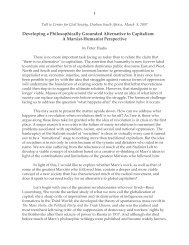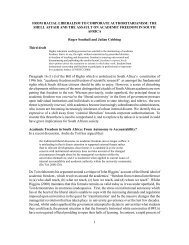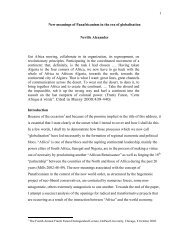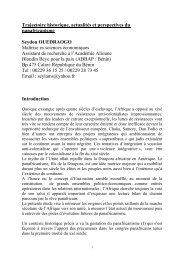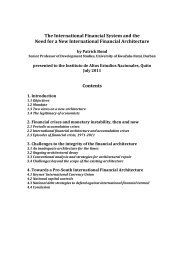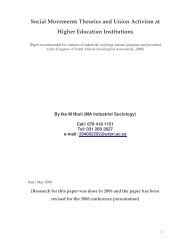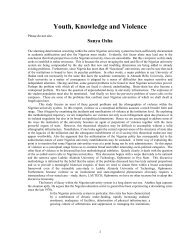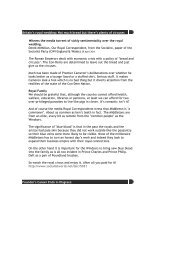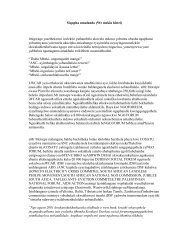The Cape of Good Dope? - Centre for Civil Society - University of ...
The Cape of Good Dope? - Centre for Civil Society - University of ...
The Cape of Good Dope? - Centre for Civil Society - University of ...
You also want an ePaper? Increase the reach of your titles
YUMPU automatically turns print PDFs into web optimized ePapers that Google loves.
terms <strong>of</strong> the composition <strong>of</strong> the crowd, the nature <strong>of</strong> the targets the crowd attacked, the<br />
historical context <strong>of</strong> time, and the specific ‘spark’ that preceded the onset <strong>of</strong> crowd<br />
violence.<br />
Charles Tilly’s early work in the raid-1960s confronted and attempted to debunk the<br />
position that violence resulted in ‘breakdowns in established moral solidarities’ (Rule<br />
1988:173). In his later collaborations with Doug McAdam and Sidney Tarrow (2001),<br />
they distinguished four bases involved in collective action and the development <strong>of</strong><br />
social movements: political opportunities, mobilising structures, collective action<br />
frames and repertoires <strong>of</strong> contention.<br />
For Le Bon, political actors are the victims <strong>of</strong> manipulation. For Tilly, collective action<br />
sees people acting together in pursuit <strong>of</strong> their interests. Action is purposeful and<br />
calculated. Contenders continuously weigh expected costs against expected benefits.<br />
<strong>The</strong> approach adopted in this study avoids viewing crowds as rational or irrational.<br />
Rather, I follow Dunning, Murphy, Newburn, and Waddington (1987), who suggest<br />
that the terms ‘rational’ and ‘irrational’ are misleading and argue that ‘it might be more<br />
fruitful to see crowds not as “rational” or “irrational”, but rather to explore the<br />
changing balance over time between what one might call the “expressive” and the<br />
“instrumental” aspects <strong>of</strong> different types <strong>of</strong> disorders’ (p. 24), ‘expressive’ violence<br />
being the cathartic release <strong>of</strong> aggression, and ‘instrumental’ violence being protest to<br />
redress grievances. Rule (1988) makes a similar point when he argues that ‘there is<br />
much to suggest that crowd action is not always strictly purposeful, if by this we mean<br />
oriented only to instrumental ends. Some militant crowd action is clearly<br />
consummatory rather than instrumental, and such action <strong>of</strong>ten includes the sorts <strong>of</strong><br />
hair-raising sadistic and destructive acts that inspired the anxiety-ridden visions <strong>of</strong> the<br />
irrationalists. Such actions appear to be ends in themselves, rather than means to some<br />
longer-term end’ (p. 242).<br />
In the case <strong>of</strong> Pagad, it will be seen that the violence that became emblematic <strong>of</strong> the<br />
movement had both consummatory and instrumental aspects. In the march to Staggie’s<br />
house, there was clearly an intention by the majority <strong>of</strong> marchers to confront him on<br />
his home turf. <strong>The</strong>re was planning and symbolism here. Once Staggie broke through<br />
the police lines and confronted the marchers, there was a spontaneous reaction.<br />
Pagad developed a particular repertoire <strong>of</strong> mobilising tactics. <strong>The</strong> march on Staggie’s<br />
headquarters became emblematic <strong>of</strong> how Pagad confronted drug-lords. A meeting<br />
would be held outside the mosque. From there marchers, some hidden behind scarves<br />
would arrive outside the shop or house <strong>of</strong> a drug dealer and demonstrate. <strong>The</strong>y would<br />
deliver a first and final warning that they had to put an end to their drug dealing or<br />
answer to the people. In the demonstration there was a deliberate attempt at shaming.<br />
According to Keenan this strategy is mostly successful in an environment where there<br />
is ‘exposure to others and susceptibility to their gaze…’ (Keenan 2004: 437).<br />
However, more <strong>of</strong>ten than not, the drug dealer was “embedded” in social networks in<br />
the community that legitimised his “business” and assuaged any feelings <strong>of</strong> guilt and<br />
shame. In any case the local drug dealer was beholden to a druglord and clearly could<br />
not meet the “first and final warning <strong>of</strong> the people”. <strong>The</strong> answer <strong>of</strong> “the people” would<br />
be a bullet. Some <strong>of</strong> the leading gangsters and drug-dealers were eliminated, creating<br />
fear and pandemonium in the ranks <strong>of</strong> the underworld.<br />
3



